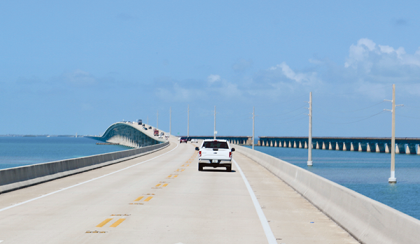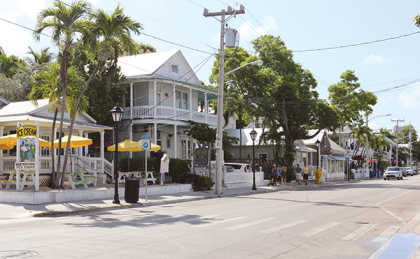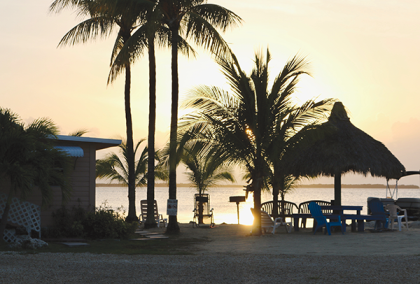Key West’s relaxing rhythm lures visitors all the way to the end of the Overseas Highway.
By Bruce Davis, F440088
January 2018
The Conch Republic is a small island located at the southernmost reach of the continental United States. Most folks know it as Key West, Florida, the last in a string of islands marking the boundary between the Atlantic Ocean and the Gulf of Mexico. But there’s much more to the Conch Republic than geography.
In addition to marvelous scenery, warm waters, and good weather, the Conch Republic vibrates. It’s a rhythm. Not apparent. Invisible. Soundless. Not detectable, really, except on an unconscious level.
 The Conch (pronounced “conk”) affects travelers and resident denizens on a subliminal level, preparing human cells, nerves, and digestive apparatus to dance, eat, and embrace life. Pay attention to the call, or you doom yourself to an unenlightened experience.
The Conch (pronounced “conk”) affects travelers and resident denizens on a subliminal level, preparing human cells, nerves, and digestive apparatus to dance, eat, and embrace life. Pay attention to the call, or you doom yourself to an unenlightened experience.
In a way, driving down the Overseas Highway from Miami toward Key West is a little like zooming in on a Google map to get more information. Except in this case it’s the Conch vibration, not Google, subtly imposing itself on a traveler. It comes at you sideways, never completely showing itself. But you hear it in the sound of the tires passing over joints in the concrete pavement, feel it in the humps and heaves of the highway, and see it in the changing hues of aquamarine water: a rhythm for all senses.
So there you are. Driving down the Overseas Highway and swinging gently up and down, your head bobbing slightly. You’re in a conga line of autos, trucks, and RVs as tires say “boompa, boompa, boom-uh, boompa, boompa, boom-uh” on the concrete; boats dance on the waves, and the color of the sea fluctuates from one shade to the next. The farther you travel, the more your senses align. Physicists call the phenomenon sympathetic vibration. It’s more like getting down — down, way down in the Conch Republic.
Old Key West
Vibrations in tune, you cross the last bridge over Cow Key Channel and drop into Key West, which is divided by old and new. Turn right at the light and drive along the Gulf shore to see new: Verizon, Walgreens, and Publix stores line one side of the road. Turn left at the light, following the Atlantic shoreline, and swing down, way down, into Old Key West. Stay in the conga line until you reach Duval Street. This is the true heart of the Conch. Here, you’re closer to Havana, Cuba, than to Miami.
Purveyors of adult beverages; wild roosters running loose; restaurants; and homes dating back to the 19th century all mingle on the narrow street. It is believed Tennessee Williams wrote A Streetcar Named Desire in the neighborhood. Ernest Hemingway lived a few blocks away. What attracted them here? What inspired all the movies, books, and plays created here? The Conch, perhaps? Vibrations, of course.
 The Conch
The Conch
So exactly what is a conch, other than a mysterious, unknowable force? Natives of Key West are called Conchs. Anyone who lives in Key West without passing the five-year-in-residence mark (some people say seven years) is humorously called a freshwater Conch. Real-life conchs (living in the ocean) are ugly, giant snails that live in beautiful shells. Human Conchs say they are good to eat; we’ll take their word for it.
The Conch Republic came about much later than the edible type of conch, in 1982, when federal agents closed the highway just east of Key West and checked each mainland-bound car for illegal immigrants or drugs. The funky conga line transformed into a burning fuse, a line of vehicles miles long. It hurt. Key West leaders asked the agents to desist. The agents refused. At that moment, the Conch Republic sprang into being. Key West symbolically “seceded” from the United States and declared war.
A Conch army assembled outside the nearby Navy base, dressed in full uniform: flip-flops, shorts, T-shirts. They lobbed a few eggs and other debris at bewildered sailors, quickly surrendered, and then requested foreign aid. The rebellion was said to last about a minute.
The new “country,” which has never rejoined the Union, adopted the motto: “We seceded where others failed.”
Often, a cool breeze arrives from the Atlantic. It blows down Duval Street and dips under hurricane shutters and then through the tan windows of 19th-century Key West. Perspiration evaporates, leaving a salty residue over most of the body. Older folks sit under their tiki huts with a cocktail and remember the warm, zephyr-filled afternoons of youth, and feel the sensual rhythm of Key West, the Conch Republic.
Stay Awhile
So. You’ve decided to go way down into the Conch Republic!
In Key West, a million different visitors will have a million unique experiences, with life down in the Conch filtered through a million individual personas. Swim, kayak, fish, sail, cruise, tour museums, or just hang in a shady spot on Duval Street to people-watch. There are plenty of things to experience. Whatever floats your boat.
In spite of all the ways the Conch presents itself to visitors, one experience is universal: returning home with a lighter pocketbook. Yup, the place is as expensive as it is quirky, and securing a place to stay will require planning and reservations for sure. Call first.
Rates are high and higher, depending on whether it’s off-season or in-season. In-season is generally December through March, and off-season is April through November. Rates are expensive compared to rates in flyover country, but well worth it, even just for a few days.
Special note: A low-cost RV park is available to active military, National Guard, reservists, retired military, 100 percent disabled veterans, Department of Defense civilians, Department of Transportation civilians working for the Coast Guard, or NATO allies on orders to the United States. Visit www.militarycampgrounds.us/florida/sigsbee-rv-park or call (305) 293-4432 to learn more.
Further Info
Note: Although Hurricane Irma damaged the Florida Keys, including Key West, in September 2017, all of the attractions and campgrounds mentioned in this article were back up and running as of mid-November 2017.
Also please note that although it is possible to drive through the town, visitors will find parking very limited. All are urged to take a trolley, “pedi” cab, or taxi, or simply walk or ride a bicycle.
The newest way to get around is the free Duval Loop bus service. It travels around downtown and through the historic seaport area. The colorful, hop-on, hop-off vehicles make 16 stops at or near the most popular locations. The buses run daily during the Keys’ winter tourism season and Thursday-Sunday otherwise.
For more information, including a complete guide with sights, services, and activities in Key West, call (800) FLA KEYS (352-5397) or visit www.fla-keys.com.
Key West Campgrounds
The following commercial RV facilities charge between $58 and $200 per night, approximately, depending on the season and the amenities they offer. For more Keys listings, check your campground directory or the RV Marketplace, published in the January issue of FMC and online at FMCA.com.
Blue Water Key
(305) 745-2494
www.bluewaterkey.com
Boyd’s Key West Campground
(305) 294-1465
www.boydscampground.com
El Mar RV Resort LLC
(305) 294-0857
www.elmarrvresort.com
Geiger Key Marina
(305) 296-3553
www.geigerkeymarina.com
Leo’s Campground
(305) 296-5260
www.leoscampground.com

